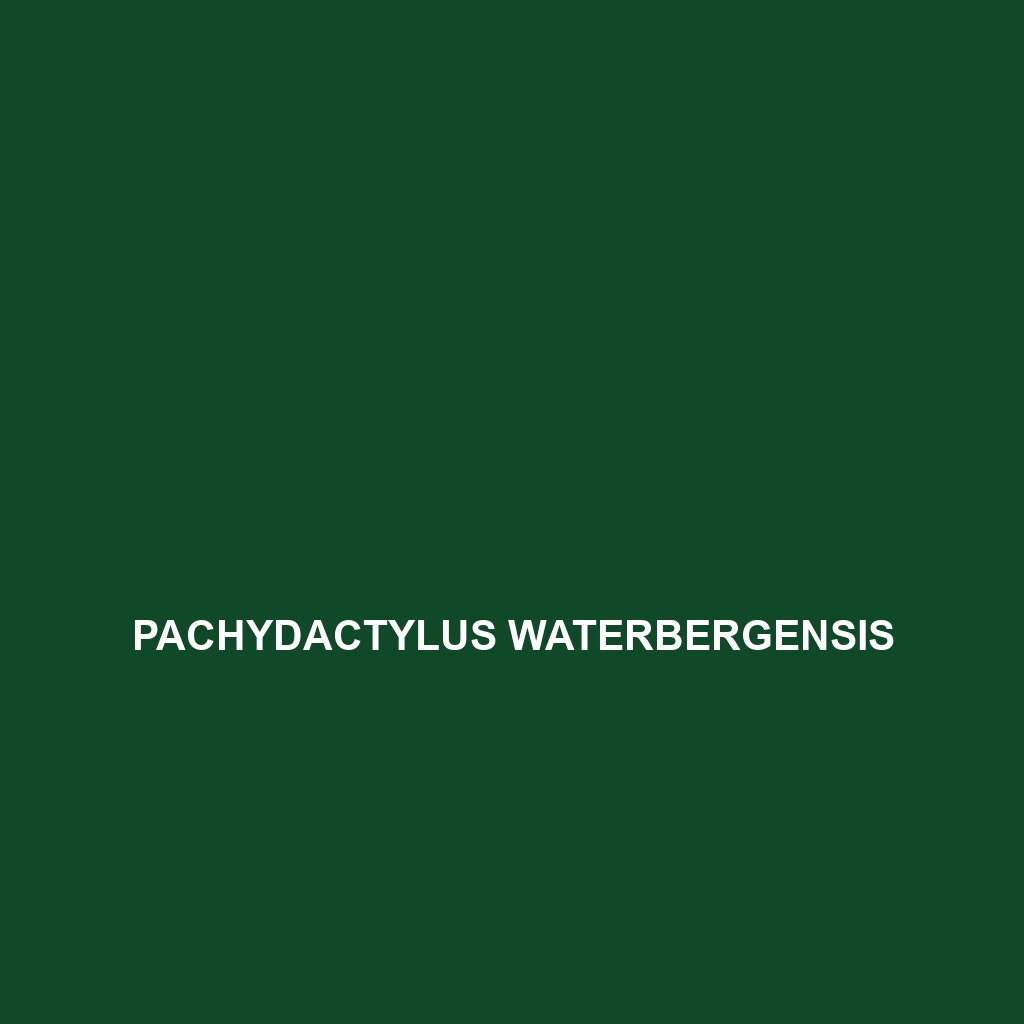Common Name
Pachydactylus waterbergensis
Scientific Name
Pachydactylus waterbergensis
Habitat
The Pachydactylus waterbergensis, commonly known as the Waterberg thick-toed gecko, is primarily found in the rocky outcrops of the Waterberg Plateau in Namibia. This captivating species thrives in a unique habitat characterized by a semi-arid climate that features savannas, semi-desert regions, and shrublands. The geological landscape of the Waterberg includes rugged terrain with ample hiding spots, providing essential shelter from predators and extreme temperatures. The ecosystem is marked by its rich biodiversity, with a mix of open plains and rocky habitats, making it an ideal environment for this gecko.
Physical Characteristics
Pachydactylus waterbergensis is a medium-sized gecko, typically measuring about 8 to 10 centimeters in length. Its body is elongated and slender, adapted for a life of climbing and maneuvering through rocky crevices. The skin features a unique color pattern—usually a light sandy or gray base adorned with darker, mottled markings. A distinctive characteristic of this species is its thickened toes, which are well-adapted for gripping rocky surfaces, aiding in climbing and stability. The presence of large, bulging eyes is an adaptation for enhanced night vision, allowing the gecko to navigate its environment effectively during nocturnal periods.
Behavior
The behavior of Pachydactylus waterbergensis is marked by its nocturnal lifestyle, making it primarily active at night. During the day, these geckos can be found resting under rocks or within the crevices of the Waterberg Plateau, avoiding the heat of the sun. They exhibit solitary behavior, coming together only during mating seasons. Mating rituals involve elaborate displays—males will often engage in head-bobbing and vocalizations to attract females. Their agility allows them to dart quickly to escape predators, and they have been observed using their swift climbing abilities to evade capture in their rocky habitat.
Diet
Pachydactylus waterbergensis is primarily an insectivore, feeding on a variety of small insects and invertebrates. Their diet typically includes crickets, beetles, and other arthropods that are abundant in their habitat. This gecko employs an active hunting strategy, using its excellent vision and agility to stalk and capture prey. Occasionally, they may consume small fruits or plant matter, suggesting a degree of omnivorous behavior. Overall, their feeding patterns are adaptive, allowing them to thrive in their semi-arid environment where food sources can fluctuate.
Reproduction
The reproductive cycle of Pachydactylus waterbergensis is closely tied to the region’s seasonal patterns. Mating usually occurs during the warmer months when food is plentiful. Female geckos typically lay one or two eggs at a time in concealed locations, ensuring the safety of their offspring from potential predators. The incubation period lasts about 45 to 60 days, after which the hatchlings emerge, fully developed and ready to fend for themselves from a young age. Maternal care is minimal, as the eggs are left to develop independently. This reproductive strategy allows populations to remain stable in their natural habitat.
Conservation Status
As of the current assessment, Pachydactylus waterbergensis holds a conservation status categorized as Least Concern by the IUCN. However, habitat loss due to land development and agricultural expansion poses a potential threat. Conservation efforts are focused on protecting the natural environment of the Waterberg Plateau to ensure that this unique species continues to thrive. Scientists and local conservationists advocate for habitat protection and restoration initiatives to mitigate these threats, making efforts essential for long-term sustainability.
Interesting Facts
One of the most fascinating aspects of Pachydactylus waterbergensis is its remarkable adaptability to the arid conditions of its habitat. They can survive with minimal water intake by efficiently metabolizing moisture from their food. Additionally, this species has developed a unique ability to change coloration based on their environment, aiding in camouflage and enhancing their survival tactics. Furthermore, these geckos are known for their chirping vocalizations, which are used to communicate during the mating season, adding an intriguing dimension to their behavior.
Role in Ecosystem
Pachydactylus waterbergensis plays a vital role in its ecosystem as both a predator and prey. By controlling insect populations, they contribute to the ecological balance within their habitat, thus supporting the health of the savanna and semi-desert environments. As prey for birds, snakes, and larger mammals, their presence is crucial in the food web. Their unique adaptations, such as their climbing abilities and nocturnal behavior, highlight their ecological significance and represent the biodiversity that defines the Waterberg region.
